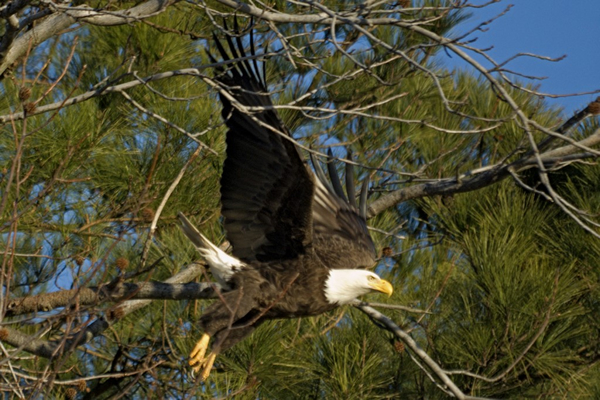- A nest site is selected and the territory is established around it.
- Nest trees are tall, large diameter trees, usually within 0.8 km (.5 mi.) of water.
- The size of a territory will be based in large part on the availability of food.
- A territory is typically circular or nearly so and is the space that each pair claims as their personal resource.
- An average territory is about 1 mile in diameter, though in areas where food is harder to find, territories may be larger than in areas where food is abundant.
- A territory can only have one active nest at a time. From year to year, the pair may abandon a nest and build another, or it may continue adding to and renovating a single nest. The second or third nests are alternative nests.
- Eagles use a loud song or call to defend their territory. The raptor tosses its head skyward several times while emitting a ringing call to perceived threats.
- In addition to calling, an eagle will also protect its territory by flying around it or by perching conspicuously near the top of a nearby tree.
- The biggest territorial threat is posed by other eagles. Floaters — adult birds without territory — may be wanting to move into existing nests. There are floater and immature males on the fringes waiting to breed.
- When an eagle intruder inadvertently flies close to or through an occupied territory, the resident adults gives chase, and in extreme cases, engages in aerial tumbling and even talon-locking.
- Owls, osprey, and hawks are a threat to the eggs, as well as hungry raccoons.
- Resident eagles are usually aggressive toward other bald eagles in the breeding area. Direct and indirect competition between neighboring pairs happens where nests are in close proximity. With abundant food, neighbors can co-exist and share foraging areas, but they do establish clear boundaries around their nests. Once territories are established and birds know their relationship to one another, there is little need to compete for resources.
- A bald eagle territory needs quality daytime perch sites. Perches are used for resting, for lookout posts with a great view in order to scan for possible predators, and for hunting.
- Several scientific studies on bald eagle perch use have determined favored perch trees are larger and taller with longer trunks than non-perch trees.
- Perch trees tend to be dead and dying and within 20 meters of shoreline.
- The life status of the perch tree (dead, dying, or alive) is less importance than tree height and proximity to water.
- There is a tendency to select coniferous trees for perching during times when deciduous trees are in leaf and a preference for deciduous perches before leaf out and after leaf drop.
|





